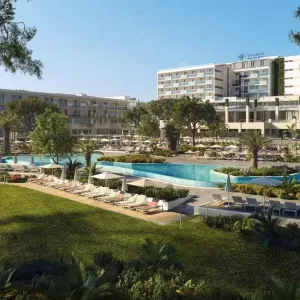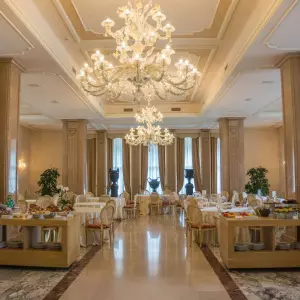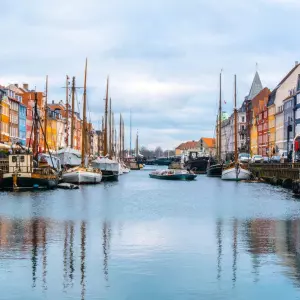We bring you a series of columns Hotel in 13 stories author Domagoj Grgić, a hospitality manager who will explain through 13 short stories from his point of view pictorial representation of the hotel and hotel business.
Domagoj Grgić He has built his career in tourism at Le Meridien Lav 5 * (Grand Casino Lav and Club Lav), Martinis - Marchi 5 *, multi-award winning Marina Frapa Resort Rogoznica and Hotel Imperial, and is currently engaged in Ireland as an ambitious and experienced manager. in Monart Spa Destination 5 * (ranked among the top 1 percent of hotels in the world by Tripadvisor for 2020).
After the first four stories, we bring you a new story Food and drink - atomic physics
Domagoj Grgić / Hotel in 13 stories: Svisualize the hotel and hotel business.
Destination - the key to success
Hotel selection - arranged marriage
Concierge - an escape to wonderland
Hotel in 13 stories: Reception - hotel altar
Food and drink - atomic physics

Food and drink - atomic physics
Chefs, waiters, sommelier, mixologists and baristas are serious social stars and it is a matter of honor to hang out and take photos with them. The villains would say, no wonder when you know how much they earn.
These facts only confirm how important it is to recognize these trends and focus on the excellence of the food and beverage department in the modern hotel industry.
The quality of food and beverages as well as the services that accompany them within the hotel usually depends on the categorization or quality of the entire hotel.
The basic division in the food department would certainly be the "buffet" and the "a la carte" concept. The "buffet" concept or popularly called "buffet" is organized in such a way that the food is presented in appropriate containers or on racks and guests are free to choose the food they want, and depending on whether it is hot or cold food, we can talk about hot and cold buffet tables. The "a la carte" offer is organized in such a way that the guest from the menu chooses food that is made just for him and brought to the table.
For those who do not want to leave the room during a meal, there is a "room service" which is used to ensure that food is delivered to the room in an appropriate way..
In theory, if the "buffet" concept of food is stored in an adequate way, the quality of food in the "buffet" and "a la carte" concept is exactly the same. The only difference is in the type of service. If you do not want to wait in line and take food out of the bowl yourself, but you want someone to serve you, then for you "a al cart" is a concept that is therefore more demanding for the hotel, requires higher costs and as a result, the final price for the guest bigger.
When we talk about the differences within the "buffet" concept, the main difference is in the quality of food and in the breadth and depth of food supply.
When we talk about the differences within the "a la carte" concept, the main difference is in the quality of food and in the concept of serving food. Here we are talking about the classic "a la carte" concept and the concept of food in sequences.
Classic "a la carte" approach characterizes the usual way of serving where the guest is free to choose from the menu absolutely everything, and then the food is served to him in the order he wants.
The concept of food in sequences characterizes the default order of dishes from which the guest can choose what he wants (except in the fixed tasting menu). The number of courses is not always the same and may vary depending on the type of cuisine (Italian, French, Lebanese, etc.) and the quality of the restaurant. In general, we can say that a guest who has chosen the concept of food in sequences, as far as food is concerned, can expect it first amuse bouche whose purpose is to "awaken" the palate and appetite of the guest, and the content of the amuse bouch itself depends on the inspiration of the chef.
It is often presented as a gift from the chef to the guest. The dish that follows has elements appetizers (there may be more), and it may be hot or cold. In order for the guest's palate to be ready for the main course after the appetizer, the guest will get it on the table sorbet. The sorbet should be cold, sweet and refreshing. After sorbet comes main course which is the central focus of the concept of food in sequences and is an unwritten rule (in many fine dine-ing restaurants) that every main dish that comes to the table must be checked or ask the guest if he is satisfied with it. After the main course comes dessert and depending on the occasion, a sweet dish such as e.g. Petit four or a dish of salty character such as e.g. selection of cheeses.
As more important trends, I would like to point out vegetarian, vegan menus and gluten free menus, as well as the trend of paying great attention to various intolerances and food allergies, as well as the "Zero waste" concept.
As for drinks, aperitifs (before meals) and digestives (after meals) are always suggested, while wine (suitable with fish, suitable with meat, dessert, sparkling), other alcoholic beverages and various mixed drinks are suggested during meals. Water and juices are an option for guests who do not drink alcohol, and various coffee-based drinks as well as teas are the basis of the offer of hot drinks.
The main and responsible person related to serving food and drinks is called “Maître d '” (hall manager), “Head waiter” is the head of the waiter and has a supervisory role, the person responsible for a particular section of the tables is called “Chef de rang” (section waiter), the person in charge of bringing food and drink to the table is called food runner (serve), and the person in charge of working in the bar is called bartender.
When we talk about drinks in general, among the people who are relevant we mention a sommelier who is an expert in wine, a mixologist who is an expert in mixed drinks and a barista who is an expert in coffee.
In order to understand the complexity of the food and beverage department as a whole, it is necessary to take a step back and understand the hierarchy within the kitchen itself.
This is where we are waiting "head chef ” which is the alpha and omega of every kitchen, "sous chef ”(assistant chef) who is the right hand of the chief chef, "chef de partie ”(eg grill master, dough expert) who is in charge of a certain part of the kitchen, "commis chef ”(young boss), "kitchen porter ” as a person in charge of peeling potatoes and similar simple tasks and "dishwasher ”(dishwasher).
For a person responsible for the income and expenses of a hotel, it is very important to know that the food and beverage department is certainly a high-risk department and at risk of creating unnecessary and huge costs on a daily basis. Buying from suppliers at high prices and questionable quality creates a high cost, but it is a negligible cost when compared to the cost of throwing away food as a result of misplanning the required number of meals.
When we think about everything written, we ask ourselves: “Is there a holy grail or a secret of success?
I will answer with a quote from a well-known Croatian boss with whom I had the opportunity to talk.
"It is not necessary for food and drink to be at the level of atomic physics, it is only necessary for food to be autochthonous and original. Make the best fillets (tripe) and bring the best local wine. And just serve them with a smile. ”
Author Domagoj Grgić / Photo:Jay Wennington on Unsplash
Hotel in 13 stories: Svisualize the hotel and hotel business.
Destination - the key to success
Hotel selection - arranged marriage









